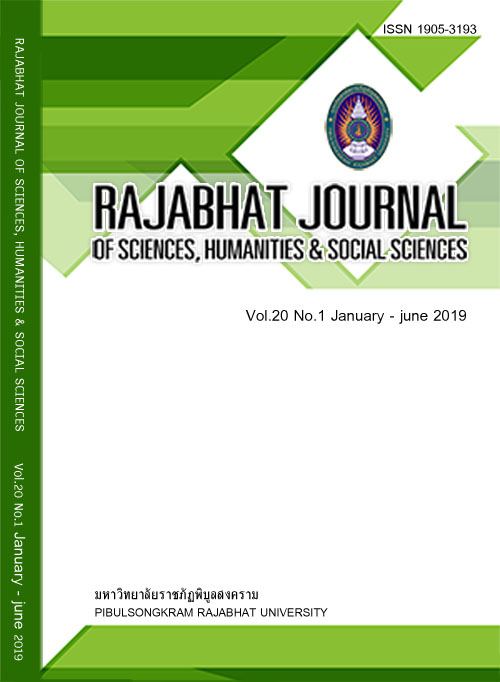THE EFFECT OF GLYCEROL CONTENT ON PHYSICAL AND MECHANICAL PROPERTIES OF THE BIODEGRADABLE FILM FROM SWEET POTATO FLOUR FOR PRESERVING NAMWA BANANA
-
Keywords:
sweet potato flour, biodegradable film, glycerol, coating film, fruit preservationAbstract
This research studied the effect of using glycerol as a plasticizer on physical and mechanical properties of a biodegradable film made from sweet potato flour. This film was coated on a fruit for a preserving purpose. The preparation of the film was done by dissolving sweet potato flour in water to the concentration of 5 wt% and the glycerol was added at 3 levels; 0, 30, and 60 wt%. The film was molded and dried at 60 oC for 18 h. The results showed that the thickness of the films, which increased with the increasing of the glycerol content, ranged between 0.34-0.39 mm. The sweet potato flour film had water vapor permeability value of 0.009-0.026 g/m2/kPa/h. The water permeability increased with the glycerol content. The tensile strength of the film dramatically decreased as a result of high glycerol content in the film. After the films were buried under the ground (8-10 cm depth) for 4 weeks, they were degraded by 16-55%. This degradation increased with the increasing of glycerol content. The films were used to preserve banana fruit. Coating the banana fruit with sweet potato film with 30% glycerol content showed the best on extending the shelf life for 3 days at room temperature. These results indicated that sweet potato flour biodegradable film could be used to preserve fruits. In addition, this made of natural film is biodegradable which can help reduce the amount of waste.
References
Chillo S, Flores S. Mastromatteo M. et al. Influence of glycerol and chitosan on tapioca starch-based
edible film properties, Journal of Food Engineering. 2008; 88: 159-168.
Choi WS, Jung HH. Physical and mechanical properties of pea-protein-base edible film, Journal Food
Science. 2001; 66(2): 319-322.
Ekthamasut K, Akesowan A. Effect of vegetable oils on physical characteristics of edible konjac films, AU Journal of Technology. 2001; 5: 73-78.
Gontard N, Guillbert S, Cuq JL. Water and glycerol as plasticizers affect mechanical and water vapour barrier properties of an edible film, The Journal of Food Science. 1993; 55(1): 206-211.
Hernandez DP, Jaramillo CM, Cordoba AL. et al. Edible cassava starch films carrying rosemary antioxidant extracts for potential use as active food packaging, Food Hydrocolloids. 2017; 63: 488-495.
Jiang F, Xiao M, Wan Li a. et al. Characterization of konjac glucomannan-ethyl cellulose film formation via microscopyInternational, Journal of Biological Macromolecules. 2016; 85: 434-441.
Jiménez A, Fabra MJ, Talens P. et al. Edible and biodegradable starch films: A review, Food and Bioprocess Technology. 2012; 5: 2058-2076.
Jomlapeeratkiul P, Poomsa-ad N, Wiset L. The Effects of drying temperatures and oil contents on properties of biodegradable film from konjac flour, Journal of the Thai Society of Agricultural Engineering. 2014; 20(2): 1-7.
Li M, Lee TC. Effect of cysteine on the functional properties and microstructure of wheat flour extrudates, Journal of Agricultural and Food Chemistry. 1996; 44: 1871-1880.
Liu X, Shiomi S, Nakatsuka A. et al. Characterization of ethylene biosynthesis associated with ripening in banana fruit, Plant Physiology. 1999; 121: 1257-1265.
Maftoonazad N, Ramaswamy HS, Moalemiyan M. et al. Effect of pectin-based edible emulsion coating on changes in quality of avocado exposed to Lasiodiplodia theobromae infection, Carbohydrate Polymers. 2007; 68: 341-349.
Mali S, Grossmann MVE, Garcia MA. et al. Effects of controlled storage on thermal, mechanical and barrier properties of plasticized films from different starch sources, Journal of Food Engineering.
2006; 75: 453-460.
Mali S, Sakanaka LS, Yamashita F. et al. Water sorption and mechanical properties of cassava starch films and their relation to plasticizing effect, Carbohydrate Polymers. 2005; 60: 283-289.
Mathlouthi, M. Water content, water activity, water structure and the stability of foodstuffs. Food Control. 2001; 12: 409-417.
Noiduang P, Thawla L, Pa-ai O. Study on edible film production from Chinese water chestnuts starch, Agricultural Science Journal. 2015; 46(3): 665-668.
Rachtanapun P, Pankan D, Srisawat D. Edible films of blended cassava starch and rice flour with sorbital and their mechanical properties, Journal of Agricultural Science and Technology. 2012; 2(2): 252-258.
Riku AT, Harry H, Yrjo HR. et al. Effect of various polyols and polyol contents on physical and mechanical properties of potato starch-based films, Carbohydrate Polymers. 2007; 67: 288-295.
Soltani M, Alimardani R, Omid M. Prediction of banana quality during ripening stage using capacitance sensing system, Australian Journail of Crop Science. 2010; 4(6): 443-447.
Sperber WH. Influence of water activity on foodborne bacteria - a review, Journal of Food Protection. 1983; 46(2): 142-150.
Thumthanaruk B, Pengpoondech P, Rodsuwan U. Quality of tapioca starch film mixed with jellyfish protein hydrolysate, Agricultural Science Journal. 2012; 43(2): 437-440.
Tsou CH, Suen MC, Yao WH. et al. Preparation and characterization of bioplastic-based green renewable composites from tapioca with acetyl tributyl citrate as a plasticizer, Materials. 2014; 7: 5617-5632.
Vieira MGA, Silva MA, Santos LO. et al. Natural-based plasticizers and biopolymer films: a review, European Polymer Journal. 2011; 47: 254-263.
Veiga SP. Sucrose and Inverted Sugar as Plasticizer. Effect on cassava starch-gelatin film mechanical properties hydrophilicity and water activity, Food Chemistry. 2007; 103: 255-262.
Wang K, Wang W, Ye R. et al. Mechanical properties and solubility in water of corn starch-collagen composite films: Effect of starch type and concentrations, Food Chemistry. 2017; 216: 209-216.
Downloads
Published
How to Cite
Issue
Section
License
Each article is copyrighted © by its author(s) and is published under license from the author(s).










